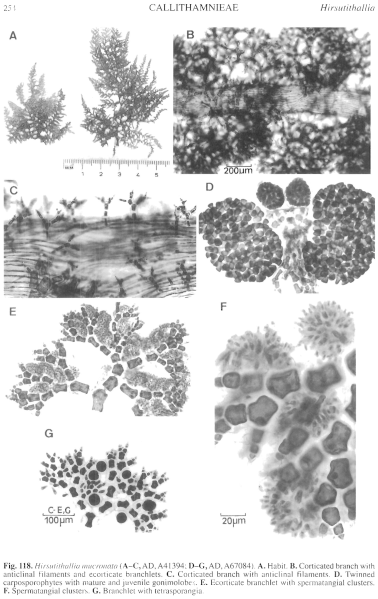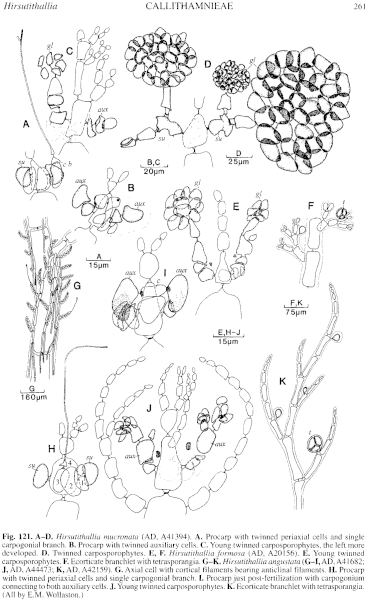|
|
|
|
|
|||||||||||
|
Electronic Flora of South Australia Species Fact Sheet
Phylum Rhodophyta – Order Ceramiales – Family Ceramiaceae – Tribe Callithamnieae
Synonym
Callithamnion laricinum Harvey in part, excluding type from W. Aust. Shepherd & Womersley 1981: 365. Womersley 1950: 177.
Thallus (Fig. 118A) erect, medium to dark red-brown, sometimes grey-red, 5–10 (–16) cm high, densely radially branched usually with several main axes bearing determinate laterals and with a narrowly pyramidal form; cortication commencing close to apices. Holdfast rhizoidal, 0.5–1 mm across; epiphytic on various algae. Structure. Ecorticate determinate branchlets 1.5–2 mm long, subdichotomous at almost right-angles (Fig. 118E, G), basal cells 45–65 µm in diameter and L/D 1.5–2 (–2.5), tapering over 10–20 cells to mucronate (especially the apical wall) terminal cells (Fig. 118F, G) basally 8–14 µm in diameter and L/D about 1, occasionally with a slender hair. Axial cells of corticated branches increasing to 200–300 µm in diameter and L/D 1–1.5, becoming densely corticated (Fig. 118B, C) with narrow descending rhizoidal filaments bearing few to dense outer anticlinal filaments 5–8 cells and 100–220 µm long, often branched near their ends. Lateral branches arising by continued growth of determinate branchlets or on their lower cells. Cells uninucleate, with other darkly-staining globules; rhodoplasts elongate to ribbon like.
Reproduction: Gametophytes dioecious. Procarps (Fig. 121A) borne on mid cells of ecorticate branchlets, with two opposite periaxial (supporting) cells, one producing a carpogonial branch; post-fertilization the carpogonium enlarges and divides, and each cell connects with an auxiliary cell (Fig. 121B) via a small connecting cell, then developing rounded carposporangial groups (Figs 118D, 121C, D) from a large basal cell, with further rounded groups often developed; fusion of the supporting cell, auxiliary cell and lower gonimoblast cell usually occurs; mature carposporangia (Fig. 118D) are irregularly ovoid and 10–25 µm across; no involucre occurs. Spermatangial clusters (Fig. 118E, F) 40–65 µm across, with a stalk cell bearing initials which directly or indirectly bear terminal spermatangia.
Tetrasporangia (Fig. 118G) are sessile on mid and upper cells of ecorticate branchlets, subspherical, 40–55 (–60) µm in diameter, tetrahedrally divided.
Type from Pennington Bay, Kangaroo I., S. Aust., drift (Kraft & Min Thein, 3.xii.1971; holotype in AD, A41394).
Selected specimens: Elliston, S. Aust., 4 m deep on Metagoniolithon radiatum (Shepherd, 22.x.1970; AD, A37510). Pearson I., S. Aust., 5 m deep on Metagoniolithon (Shepherd, 8.i.1969; A33974). Port Elliot, S. Aust., drift on Phacelocarpus (Womersley, 10.viii.1957; A21110). West Bay, Kangaroo I., S. Aust., drift (Womersley, 6.i.1946; AD, A3213). Pennington Bay, Kangaroo I., S. Aust., 1 m deep on reef edge on Laurencia elata (Womersley, 15.i.1946; AD, A2840 and 26.xii.1948; AD, A10519). Cape Northumberland, S. Aust., low eulittoral, on Codium fragile (Womersley, 8.xii.1991; AD, A61556 - "Marine Algae of southern Australia" No. 393). Port MacDonnell, S. Aust., drift on Phacelocarpus peperocarpos (Womersley, 24.xi.1992; AD, A62214). Warrnambool, Vic., drift on Plocamiutn angustum (Lucas, Jan. 1927; AD, A2066). Point Lonsdale, Vic., on Codium fragile (Warnock, 20.xi.1934; Tilden, South Pacific Plants Ser. 2, 124; AD, A50158). Inverloch, Vic. (Hansen, Jan. 1959; MELU, 608830). Green Point, NW Tas., drift on Codium fragile (Womersley, 17.x.1982; AD, A55608). Bicheno, Tas., on C. fragile, lower eulittoral (Womersley, 3.xi.1982; AD, A56465). Safety Cove, Port Arthur, Tas., lower eulittoral (Gordon-Mills, 16.ii.1986; AD, A57061). Alonnah, Bruny I., Tas., upper sublittoral on C. fragile (Wollaston & Mitchell, 28.ii.1964; AD, A27926).
Distribution: Elliston, S. Aust., to Inverloch, Vic., and around Tasmania.
Taxonomic notes: H. mucronata differs from all other species of the genus in having mucronate terminal cells of the branchlets. It has been frequently confused with H. laricina, but differs in this manner, in having rounded rather than pyramidal carposporophytes, and in being a more robust species, epiphytic on various algae on rough-water coasts. On the south coast of Kangaroo I. it is common on Laurencia elata but where Codium fragile occurs (SE S. Aust. to Tasmania) it is a common epiphyte on it, though in Tasmania the H. mucronata plants are generally only 1 cm or so high.
Harvey included specimens from Port Fairy, Vic. (e.g. Tray. Set 200 and Alg. Aust. Exsicc. 510D) under Callithamnion laricinum (in NSW, 401736, 401740) but they clearly show mucronate terminal cells.
References:
SHEPHERD, S.A. & WOMERSLEY, H.B.S. (1981). The algal and seagrass ecology of Waterloo Bay, South Australia. Aquat. Bot. 11, 305–371.
WOMERSLEY, H.B.S. (1950). The marine algae of Kangaroo Island. III. List of Species 1. Trans. R. Soc. S. Aust. 73, 137–197.
The Marine Benthic Flora of Southern Australia Part IIIC complete list of references.
Publication:
Womersley, H.B.S. (24 December, 1998)
The Marine Benthic Flora of Southern Australia
Rhodophyta. Part IIIC. Ceramiales – Ceramiaceae, Dasyaceae
©State Herbarium of South Australia, Government of South Australia
Illustrations in Womersley Part IIIA, 1998: FIGS 118, 121 A–D.

Figure 118 enlarge
Fig. 118. Hirsutithallia mucronata (A–C, AD, A41394; D–G, AD, A67084). A. Habit. B. Corticated branch with anticlinal filaments and ecorticate branchlets. C. Corticated branch with anticlinal filaments. D. Twinned carposporophytes with mature and juvenile gonimolobes. E. Ecorticate branchlet with spermatangial clusters. F. Spermatangial clusters. G. Branchlet with tetrasporangia.

Figure 121 enlarge
Fig. 121. A–D. Hirsutithallia mucronata (AD, A41394). A. Procarp with twinned periaxial cells and single carpogonial branch. B. Procarp with twinned auxiliary cells. C. Young twinned carposporophytes, the left more developed. D. Twinned carposporophytes. E, F. Hirsutithallia formosa (AD, A20156). E. Young twinned carposporophytes. F. Ecorticate branchlet with tetrasporangia. G–K. Hirsutithallia angustata (G–I, AD, A41682; J, AD, A44473; K, AD, A42159). G. Axial cell with cortical filaments bearing anticlinal filaments. H. Procarp with twinned periaxial cells and single carpogonial branch. I. Procarp just post-fertilization with carpogonium connecting to both auxiliary cells. J. Young twinned carposporophytes. K. Ecorticate branchlet with tetrasporangia. (All by E.M. Wollaston.)

|
Email Contact: State Herbarium of South Australia |

|